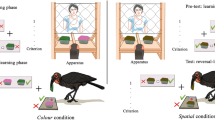Abstract
Male mammals typically outperform their conspecific females on spatial tasks. A sex difference in cues used to solve the task could underlie this performance difference as spatial ability is reliant on appropriate cue use. Although comparative studies of memory in food-storing and non-storing birds have examined species differences in cue preference, few studies have investigated differences in cue use within a species. In this study, we used a one-trial associative food-finding task to test for sex differences in cue use in the great tit, Parus major. Birds were trained to locate a food reward hidden in a well covered by a coloured cloth. To determine whether the colour of the cloth or the location of the well was learned during training, the birds were presented with three wells in the test phase: one in the original location, but covered by a cloth of a novel colour, a second in a new location covered with the original cloth and a third in a new location covered by a differently coloured cloth. Both sexes preferentially visited the well in the training location rather than either alternative. As great tits prefer colour cues over spatial cues in one-trial associative conditioning tasks, cue preference appears to be related to the task type rather than being species dependent.

Similar content being viewed by others
References
Astié AA, Kacelnik A, Reboreda JC (1998) Sexual differences in memory in shiny cowbirds. Anim Cogn 1:77–82
Bentley GE, Demas GE, Nelson RJ, Ball GF (1998) Melatonin, immunity and cost of reproductive state in male European starlings. Proc R Soc Lond Ser B 265:1191–1195
Brodbeck DR (1994) Memory for spatial and local cues: a comparison of a storing and a nonstoring species. Anim Learn Behav 22:119–133
Brodbeck DR, Shettleworth SJ (1995) Matching location and color of a compound stimulus—comparison of a food-storing and a nonstoring bird species. J Exp Psych: Anim Behav Proc 21:64–77
Clayton NS, Krebs JR (1994) One-trial associative memory—comparison of food-storing and nonstoring species of birds. Anim Learn Behav 22:366–372
Galea LAM, Kavaliers M, Ossenkopp K-P, Innes D, Hargreaves EL (1994) Sexually dimorphic spatial learning varies seasonally in two populations of deer mice. Brain Res 635:18–26
Galea LAM, McEwen BS (1999) Sex and seasonal differences in the rate of cell proliferation in the dentate gyrus of adult wild meadow voles. Neuroscience 89:955–964
Halpern DF (1991) Sex differences in cognitive abilities, 2nd edn. Erlbaum, Hillsdale, N.J.
Hampton RR, Shettleworth SJ (1996) Hippocampus and memory in a food-storing and in a nonstoring bird species. Behav Neurosci 110:946–964
Jacobs LF, Gaulin SJC, Sherry DF, Hoffman GE (1990) Evolution of spatial cognition: sex-specific patterns of spatial behavior predict hippocampal size. Proc Natl Acad Sci USA 87:6349–6352
Juss TS (1993) Neuroendocrine and neural changes associated with the photoperiodic control of reproduction. In: Sharp PJ (ed) Avian endocrinology. Society for Endocrinology, Bristol, UK, pp 47–60
Kavaliers M, Ossenkopp KP, Galea LAM, Kolb B (1998) Sex differences in spatial learning and prefrontal and parietal cortical dendritic morphology in the meadow vole, Microtus pennsylvanicus. Brain Res 810:41–47
Kelly DM, Spetch ML, Heth CD (1998) Pigeons’ (Columba livia) encoding of geometric and featural properties of a spatial environment. J Comp Psychol 112:259–269
Meddle SL, Foidart A, Wingfield JC, Ramenofsky M, Balthazart J (1999) Effects of sexual interactions with a male on Fos-like immunoreactivity in the female quail brain. J Neuroendocrinol 11:771–784
Nicholls TJ, Goldsmith AR, Dawson A (1988) Photorefractoriness in birds and comparison with mammals. Physiol Rev 68:133–176
Perrot-Sinal TS, Kavaliers M, Ossenkopp KP (1998) Spatial learning and hippocampal volume in male deer mice: relations to age, testosterone and adrenal gland weight. Neuroscience 86:1089–1099
Raz N, Gunning FM, Head D, Dupuis JH, McQuain J, Briggs SD, Loken WJ, Thornton AE, Acker JD (1997) Selective aging of the human cerebral cortex observed in vivo: Differential vulnerability of the prefrontal gray matter. Cereb Cortex 7:268–282
Reboreda JC, Clayton NS, Kacelnik A (1996) Species and sex differences in hippocampus size in parasitic and non-parasitic cowbirds. Neuroreport 7:505–508
Roof RL, Havens MD (1992) Testosterone improves maze performance and induces development of a male hippocampus in females. Brain Res 572:310–313
Sandstrom NJ, Kaufman J, Huettel SA (1998) Males and females use different distal cues in a virtual environment navigation task. Cogn Brain Res 6:351–360
Saucier DM, Green SM, Leason J, MacFadden A, Bell S, Elias LJ (2002) Are sex differences in navigation caused by sexually dimorphic strategies or by differences in the ability to use the strategies? Behav Neurosci 116:403–410
Sokal RR, Rohlf FJ (1981) Biometry, 2nd edn. Freeman, New York
Sovrano VA, Bisazza A, Vallortigara G (2003) Modularity as a fish (Xenotoca eiseni) views it: conjoining geometric and nongeometric information for spatial reorientation. J Exp Psychol-Anim Behav Process 29:199–210
Tommasi L, Vallortigara G (2004) Hemispheric processing of landmark and geometric information in male and female domestic chicks (Gallus gallus). Behav Brain Res 155:85–96
Vallortigara G (1996) Learning of colour and position cues in domestic chicks: males are better at position, females at colour. Behav Proc 36:289–296
Williams CL, Barnett AM, Meck WH (1990) Organizational effects of gonadal secretions on sexual differentiation in spatial memory. Behav Neurosci 104:84–97
Williams CL, Meck WH (1991) The organizational effects of gonadal steroids on sexually dimorphic spatial ability. Psychoneuroendocrinol 16:155–176
Acknowledgements
We would like to thank Evelyn Rutherford for bird care, BBSRC for funding Z.H. and Tom Smulders, Julian Christians and three anonymous referees for helpful comments on an earlier version of the manuscript. The work described in the manuscript complied with all of the relevant UK laws
Author information
Authors and Affiliations
Corresponding author
About this article
Cite this article
Hodgson, Z.G., Healy, S.D. Preference for spatial cues in a non-storing songbird species. Anim Cogn 8, 211–214 (2005). https://doi.org/10.1007/s10071-004-0249-4
Received:
Revised:
Accepted:
Published:
Issue Date:
DOI: https://doi.org/10.1007/s10071-004-0249-4




